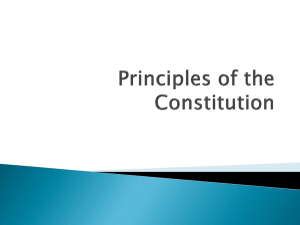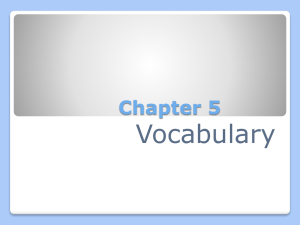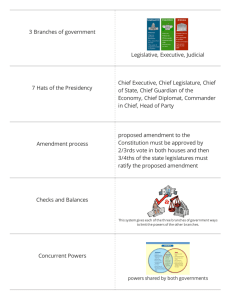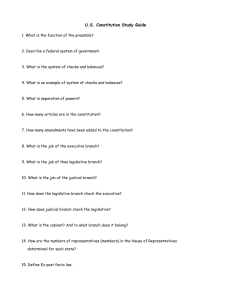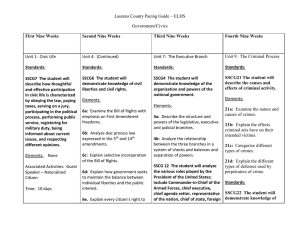Claim Your Powers
advertisement
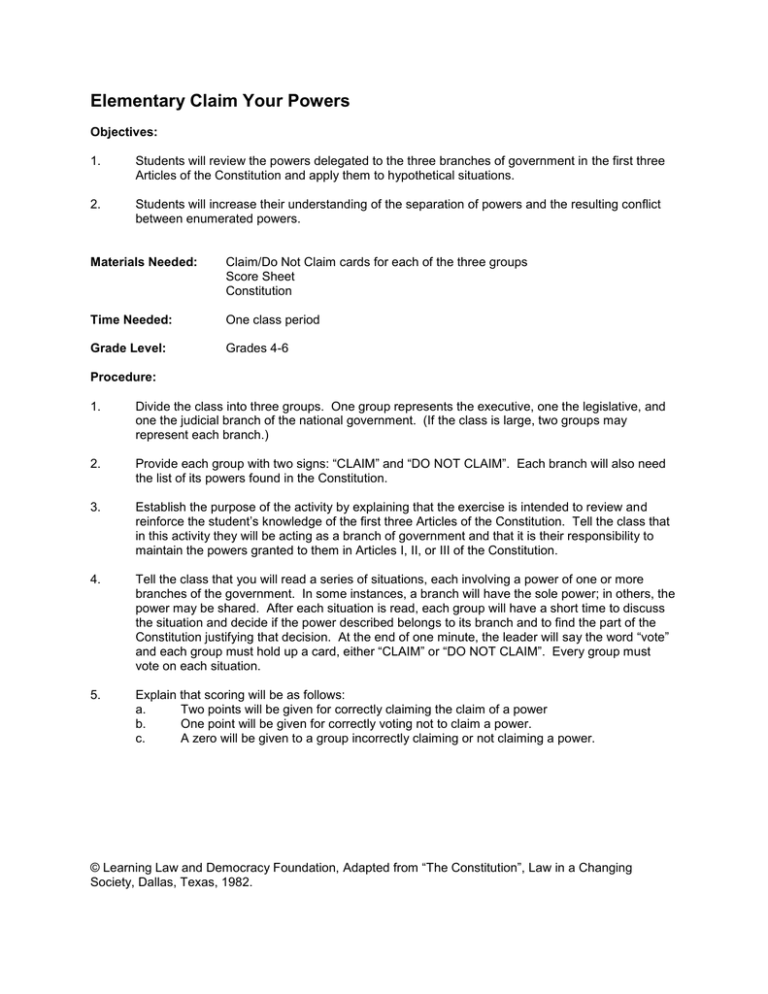
Elementary Claim Your Powers Objectives: 1. Students will review the powers delegated to the three branches of government in the first three Articles of the Constitution and apply them to hypothetical situations. 2. Students will increase their understanding of the separation of powers and the resulting conflict between enumerated powers. Materials Needed: Claim/Do Not Claim cards for each of the three groups Score Sheet Constitution Time Needed: One class period Grade Level: Grades 4-6 Procedure: 1. Divide the class into three groups. One group represents the executive, one the legislative, and one the judicial branch of the national government. (If the class is large, two groups may represent each branch.) 2. Provide each group with two signs: “CLAIM” and “DO NOT CLAIM”. Each branch will also need the list of its powers found in the Constitution. 3. Establish the purpose of the activity by explaining that the exercise is intended to review and reinforce the student’s knowledge of the first three Articles of the Constitution. Tell the class that in this activity they will be acting as a branch of government and that it is their responsibility to maintain the powers granted to them in Articles I, II, or III of the Constitution. 4. Tell the class that you will read a series of situations, each involving a power of one or more branches of the government. In some instances, a branch will have the sole power; in others, the power may be shared. After each situation is read, each group will have a short time to discuss the situation and decide if the power described belongs to its branch and to find the part of the Constitution justifying that decision. At the end of one minute, the leader will say the word “vote” and each group must hold up a card, either “CLAIM” or “DO NOT CLAIM”. Every group must vote on each situation. 5. Explain that scoring will be as follows: a. Two points will be given for correctly claiming the claim of a power b. One point will be given for correctly voting not to claim a power. c. A zero will be given to a group incorrectly claiming or not claiming a power. © Learning Law and Democracy Foundation, Adapted from “The Constitution”, Law in a Changing Society, Dallas, Texas, 1982. Situations (these may be read aloud or written on index cards and distributed to each group) a. A law requiring school buses to have seat belts for all students is passed. b. You hold your office for life during good behavior. c. The United States needs an ambassador to Argentina. d. There is a vacancy on the Supreme Court and a new justice must be nominated. e. Can override a veto by two-thirds vote. f. The state of Arizona is suing California over water rights. g. This branch runs the military. h. A law passed by the state of Louisiana has been challenged as being unconstitutional. i. Ralph Z. is being tried for internet computer hacking. j. Impeachment trial against the president is being conducted. k. A bill is vetoed. l. A State of the Union message is given. m. A Secretary of Defense appointment is approved. n A law is declared unconstitutional. o. War is declared on Sweden. p. A tax cut is being voted on. q. The decision of a trial court is being reviewed. Claim Your Powers Score Sheet (points possible) Situation Branches Judicial Claim a. b. No Claim 1 Executive Claim 2 2 1 2 d. 1 2 e. 1 h. 2 i. 2 j. 2 1 2 1 2 1 1 No Claim 2 1 2 g. Claim 1 c. f. No Claim Legislative 1 2 1 1 1 2 1 1 2 k. 1 2 1 l. 1 2 1 m. 1 n. 1 2 2 1 1 o. 1 1 2 p. 1 1 2 q. 2 TOTAL 14 1 10 14 10 1 14 10 Claim Your Powers Score Sheet Situation Branches Judicial Claim a. b. c. d. e. f. g. h. i. j. k. l. m. n. o. p. q. TOTAL No Claim Executive Claim No Claim Legislative Claim No Claim Claim Do Not Claim

